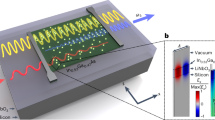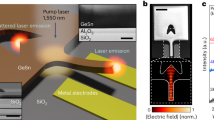Abstract
As a result of advances in nanotechnology and the burgeoning capabilities for fabricating materials with controlled nanoscale geometries, the traditional notion of what constitutes an optical device continues to evolve. The fusion of maturing low-cost lithographic techniques with newer optical design strategies has enabled the introduction of artificially structured metamaterials in place of conventional materials for improving optical components as well as realizing new optical functionality. Here we demonstrate multilayer, lithographically patterned, subwavelength, metal elements, whose distribution forms a computer-generated phase hologram in the infrared region (10.6 μm). Metal inclusions exhibit extremely large scattering and can be implemented in metamaterials that exhibit a wide range of effective medium response, including anomalously large or negative refractive index; optical magnetism; and controlled anisotropy. This large palette of metamaterial responses can be leveraged to achieve greater control over the propagation of light, leading to more compact, efficient and versatile optical components.
This is a preview of subscription content, access via your institution
Access options
Subscribe to this journal
Receive 12 print issues and online access
$259.00 per year
only $21.58 per issue
Buy this article
- Purchase on Springer Link
- Instant access to full article PDF
Prices may be subject to local taxes which are calculated during checkout






Similar content being viewed by others
References
Gordon, J. M. Spherical gradient-index lenses as perfect imaging and maximum power transfer devices. Appl. Opt. 39, 3825–3832 (2000).
Pendry, J. B., Schurig, D. & Smith, D. R. Controlling electromagnetic fields. Science 312, 1780–1782 (2006).
Schurig, D. et al. Metamaterial electromagnetic cloak at microwave frequencies. Science 314, 977–980 (2006).
Dobrowolski, J. A. in Handbook of Optics 2nd edn, Vol. 1 (eds Bass, M. & Stryland, E. W. V.) Ch. 42 (McGraw Hill, 1995).
Yakhkind, A. K. Optical graded-index elements made from glass. Optic. Zh. 70, 54–60 (2003) J. Opt. Technol. 70 877–881 (2003) (transl.).
Jin, Y., Tai, H., Hiltner, A., Baer, E. & Shirk, J. S. New class of bioinspired lenses with a gradient refractive index. J. Appl. Polym. Sci. 103, 1834–1841 (2007).
Glezer, E. N. et al. Three-dimensional optical storage inside transparent materials. Opt. Lett. 21, 2023–2025 (1996).
Freese, W., Kämpfe, T., Kley, E-B. & Tünnermann, A. Design of binary subwavelength multiphase level computer generated holograms. Opt. Lett. 35, 676–678 (2010).
Levy, U., Kim, H-C., Tsai, C-H. & Fainman, Y. Near-infrared demonstration of computer generated holograms implemented by using subwavelength gratings with space-variant orientation. Opt. Lett. 30, 2089–2091 (2005).
Choi, M. et al. A terahertz metamaterial with unnaturally high refractive index. Nature 470, 369–374 (2011).
Smith, D. R., Schultz, S., Markoš, P. & Soukoulis, C. M. Determination of effective permittivity and permeability of metamaterials from reflection and transmission coefficients. Phys. Rev. B 65, 195104 (2002).
Ordal, M. A. et al. Optical properties of the metals Al, Co, Cu, Au, Fe, Pb, Ni, Pd, Pt, Ag, Ti, and W in the infrared and far infrared. Appl. Opt. 22, 1099–1119 (1983).
Lovrinčić, R. & Pucci, A. Infrared optical properties of chromium nanoscale films with a phase transition. Phys. Rev. B 80, 205404 (2009).
Tsai, Y-J. et al. Design and fabrication of a metamaterial gradient index diffraction grating at infrared wavelengths. Opt. Express 19, 24411–24423 (2011).
Smith, D. R. Analytic expressions for the constitutive parameters of magnetoelectric metamaterials. Phys. Rev. E 81, 036605 (2010).
Gerchberg, R. W. & Saxton, W. O. A practical algorithm for the determination of phase from image and diffraction plane pictures. Optik 35, 237–246 (1972).
Wyrowski, F. Design theory of diffractive elements in the paraxial domain. J. Opt. Soc. Am. A 10, 1553–1561 (1993).
Walther, B., Helgert, C., Rockstuhl, C. & Pertsch, T. Diffractive optical elements based on plasmonic metamaterials. Appl. Phys. Lett. 98, 191101 (2011).
Gerke, T. D. & Piestun, R. Aperiodic volume optics. Nature Photon. 4, 188–193 (2010).
Acknowledgements
This work was supported by a Multidisciplinary University Research Initiative, sponsored by the US Army Research Office (Grant No. W911NF-09-1-0539).
Author information
Authors and Affiliations
Contributions
S.L., Y-J.T. and D.R.S. conceived the application of metamaterials for holography and designed the experiment. T.T. and N.M.J. developed the fabrication protocols. Y-J.T. carried out simulations and characterization. T.T. fabricated the sample. S.L. wrote the manuscript.
Corresponding authors
Ethics declarations
Competing interests
The authors declare no competing financial interests.
Supplementary information
Supplementary Information
Supplementary Information (PDF 335 kb)
Rights and permissions
About this article
Cite this article
Larouche, S., Tsai, YJ., Tyler, T. et al. Infrared metamaterial phase holograms. Nature Mater 11, 450–454 (2012). https://doi.org/10.1038/nmat3278
Received:
Accepted:
Published:
Issue Date:
DOI: https://doi.org/10.1038/nmat3278
This article is cited by
-
Dual-Mode Metamaterial Absorber for Independent Sweat and Temperature Sensing
Journal of Electronic Materials (2023)
-
Intelligent metasurfaces: control, communication and computing
eLight (2022)
-
Hydrodynamic metasurface for programming electromagnetic beam scanning on the Azimuth and elevation planes
Microsystems & Nanoengineering (2022)
-
Imaging with metamaterials
Nature Reviews Physics (2021)
-
Implementing fractional Fourier transform using SH0 wave computational metamaterials in space domain
Science China Technological Sciences (2021)



